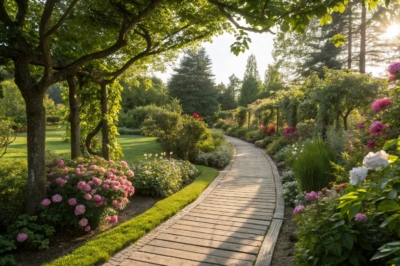1. Natural Edging
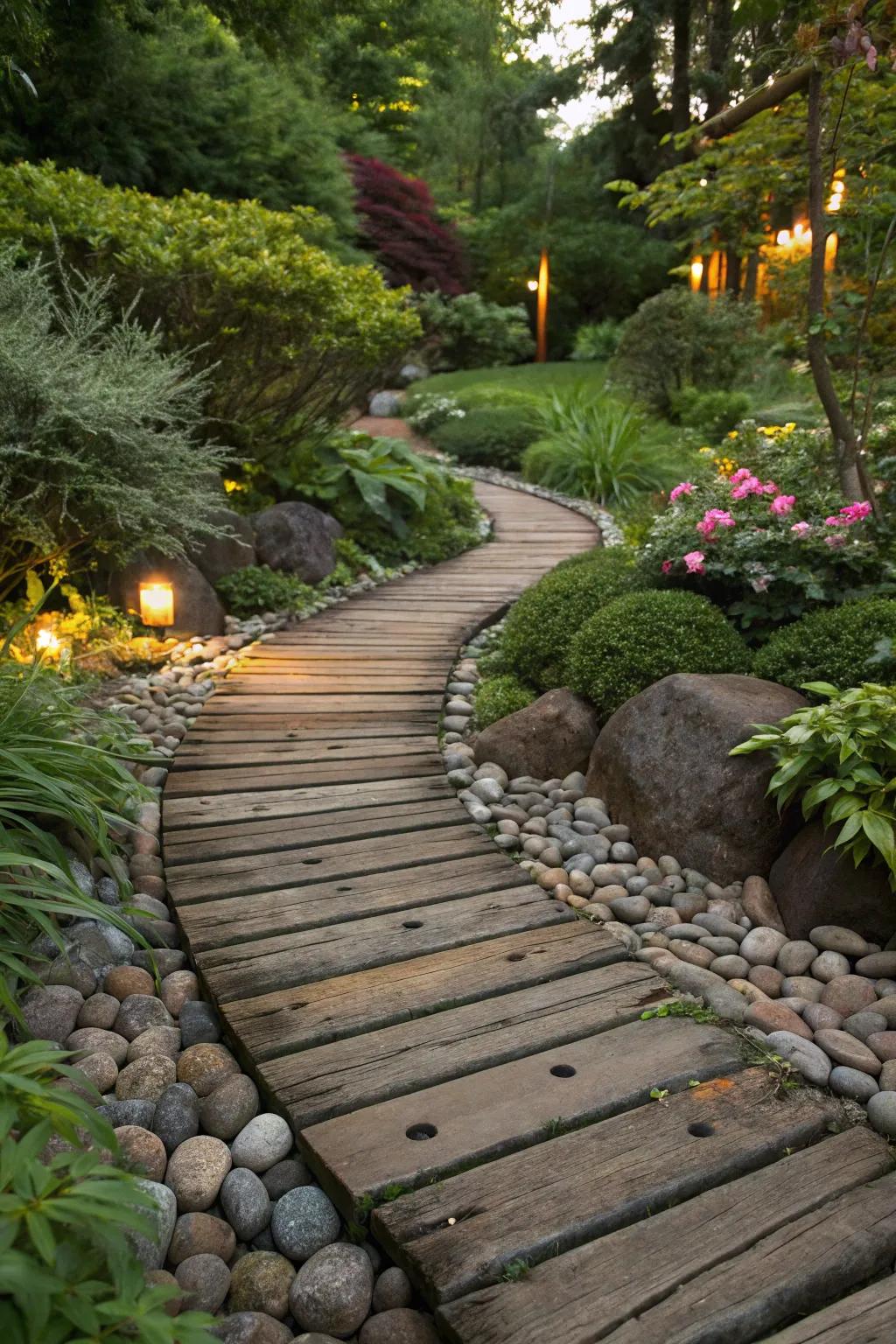
Use natural materials for edging to define your pathways. I love using river stones to edge my paths, which blends beautifully with the garden’s organic feel.
Try these:
- River Stones for Garden Edging: Enhance your pathway’s natural look with river stones, creating a seamless blend with nature.
- Natural Garden Pathway Lights: Illuminate and define your pathway with elegant, nature-inspired garden lights for evening ambiance.
- Wooden Garden Pathway Planks: Create a rustic and sturdy wooden pathway, perfectly complementing your garden’s aesthetic.
2. Creative Plank Arrangements

Why stick to straight lines? Try staggered or patterned plank layouts to add visual interest to your pathways. In my garden, I experimented with a herringbone design, and it became the highlight of my outdoor space.
Maybe worth checking out:
- Outdoor Wooden Deck Tiles: Enhance your garden pathway with easy-to-install wooden deck tiles for a stylish look.
- Herringbone Wood Plank Kit: Create an eye-catching herringbone design with this easy-to-use wood plank kit.
- Garden Edge Weatherproof Sealant: Ensure durability in your pathways with high-quality weatherproof sealant for wooden surfaces.
3. Curved Wooden Pathway

Curves add a graceful flow to any garden, and a curved wooden pathway can beautifully guide visitors through your green haven. I once crafted a gentle, winding path in my backyard, and it effortlessly connected various garden sections with a natural rhythm.
Possibly handy products:
- Wooden Garden Pathway Kit: Transform your garden with this easy-to-install wooden pathway kit, enhancing its natural beauty.
- Outdoor Wood Protector: Protect your pathway from the elements with this durable outdoor wood protector for lasting beauty.
- LED Pathway Lights: Illuminate your garden path with these stylish LED lights, perfect for nighttime ambiance.
4. Zen Garden Pathway
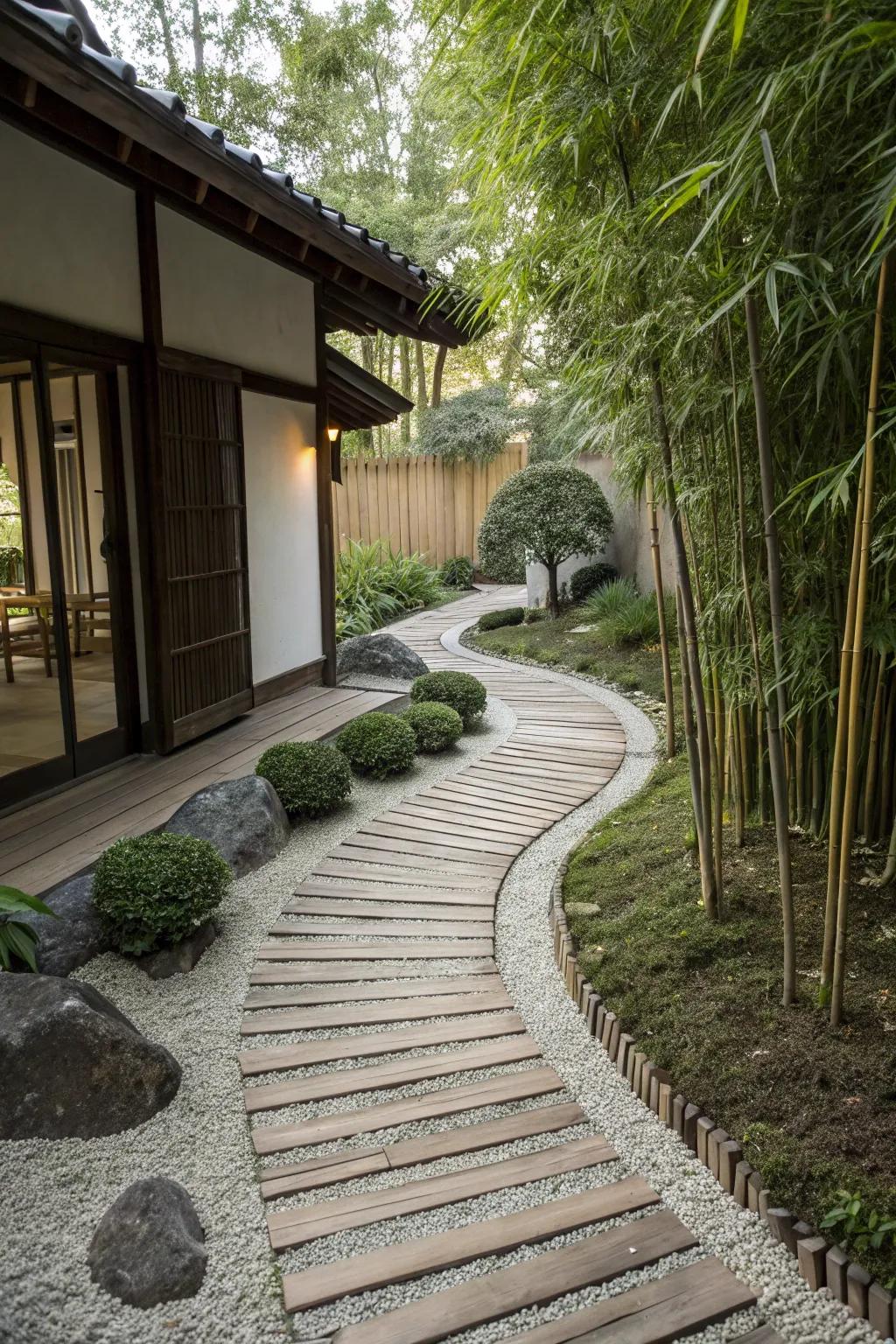
Create a serene Zen garden path using wood and stones. My backyard features a tranquil path lined with bamboo and raked pebbles for a meditative atmosphere.
A few relevant products:
- Wooden Garden Pathway: Enhance your Zen garden’s tranquility with a durable wooden pathway for serene strolls.
- Decorative Garden Pebbles: Create meditative patterns with decorative pebbles, perfect for a peaceful Zen garden path.
- Bamboo Garden Fence: Add a touch of privacy and elegance with a natural bamboo fence along your path.
5. Themed Garden Paths

Create a themed path that tells a story or evokes a particular feeling. My garden features a nautical-themed path with driftwood and shells, transporting visitors to the seaside.
Consider these options:
- Driftwood Pieces for Crafts: Enhance your nautical theme with natural driftwood pieces for a genuine seaside feel.
- Decorative Sea Shells: Add a touch of the ocean with assorted decorative sea shells along your garden path.
- Outdoor Pathway Lights: Illuminate your garden path with stylish outdoor lights to enhance your nautical theme at night.
6. Functional Access
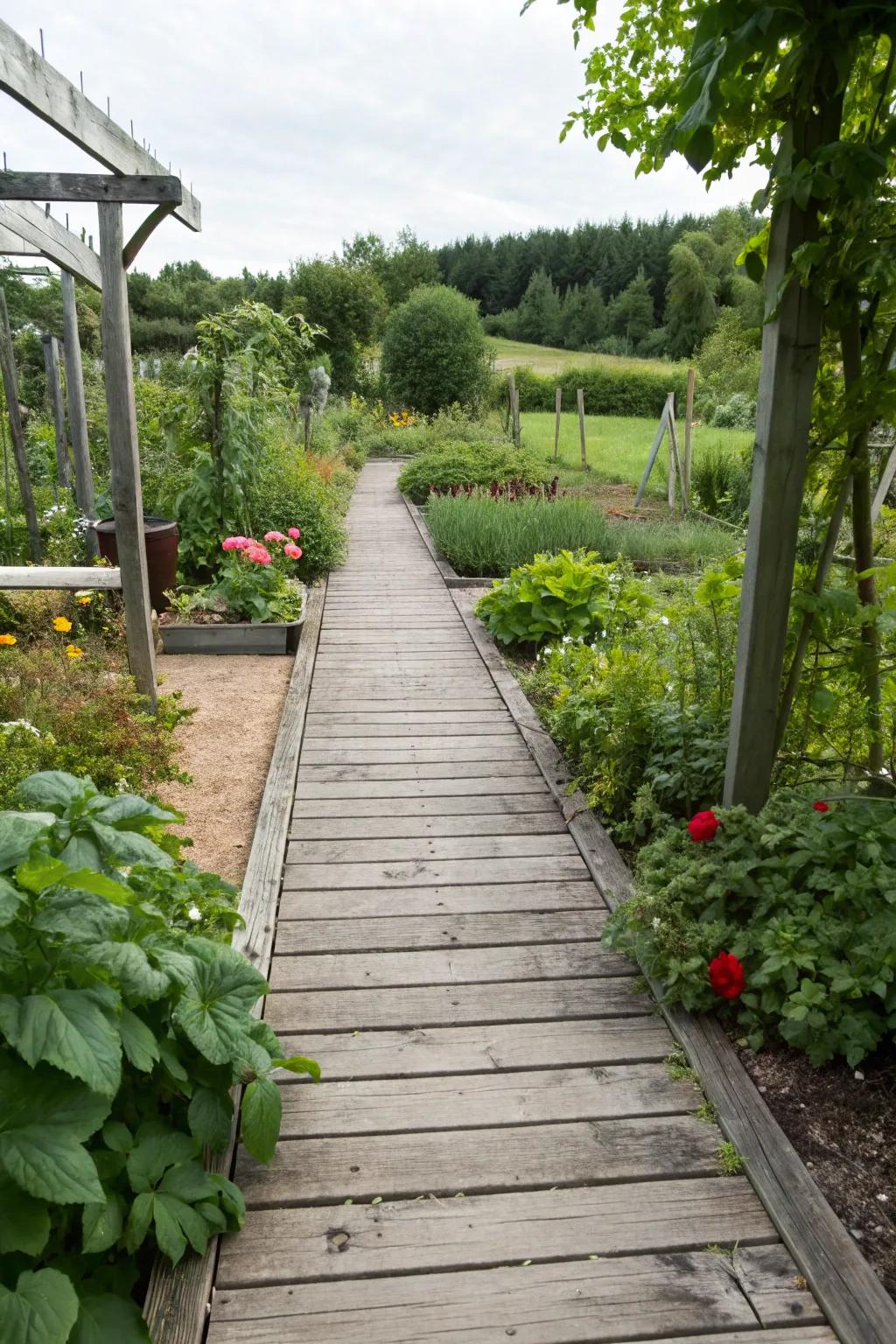
Design your pathway to provide practical access through your garden. My wooden path leads directly from the patio to the vegetable garden, making it easy to carry tools and harvests.
Items that may come in handy:
- Garden Cart with Large Wheels: Easily transport tools and harvests along your wooden path with this versatile garden cart.
- Weatherproof Wood Stain: Protect your wooden pathway from the elements with durable, weather-resistant wood stain.
- Outdoor Solar Path Lights: Illuminate your garden pathway at night with eco-friendly, easy-to-install solar path lights.
7. Integration with Greenery
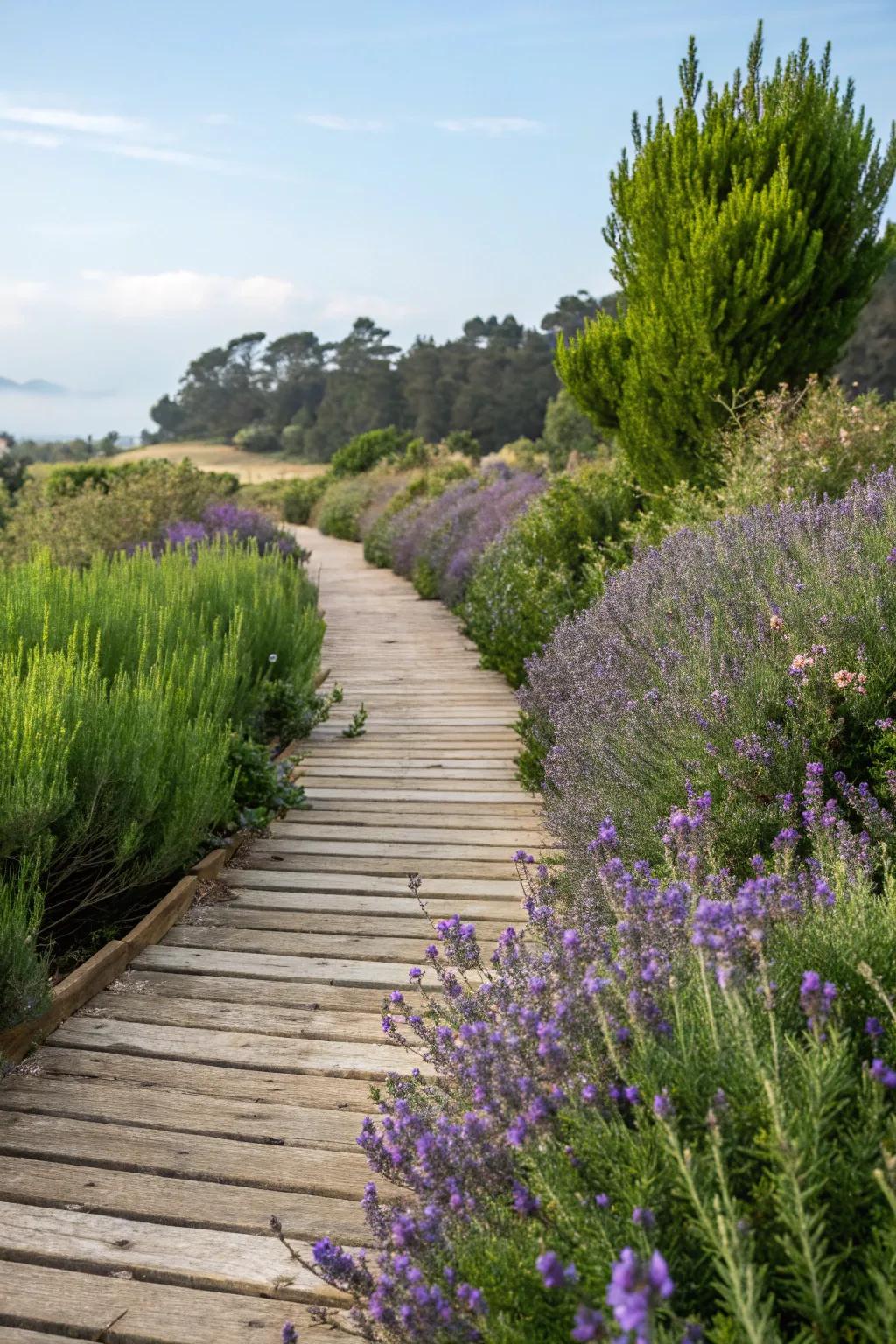
Let your wooden pathway blend seamlessly with nature by lining it with lush plants and flowers. I love how my path is bordered with lavender and rosemary; it’s both fragrant and visually pleasing.
Possibly helpful picks:
- Lavender Plants for Garden: Enhance your pathway with fragrant lavender, adding beauty and a calming scent to your garden.
- Rosemary Plants for Landscaping: Add structure and aroma to your pathway with robust rosemary plants, perfect for edging.
- Wooden Garden Pathway Edging: Define your path with durable wooden edging, harmonizing your walkway with natural elements.
8. Variety of Wood Tones
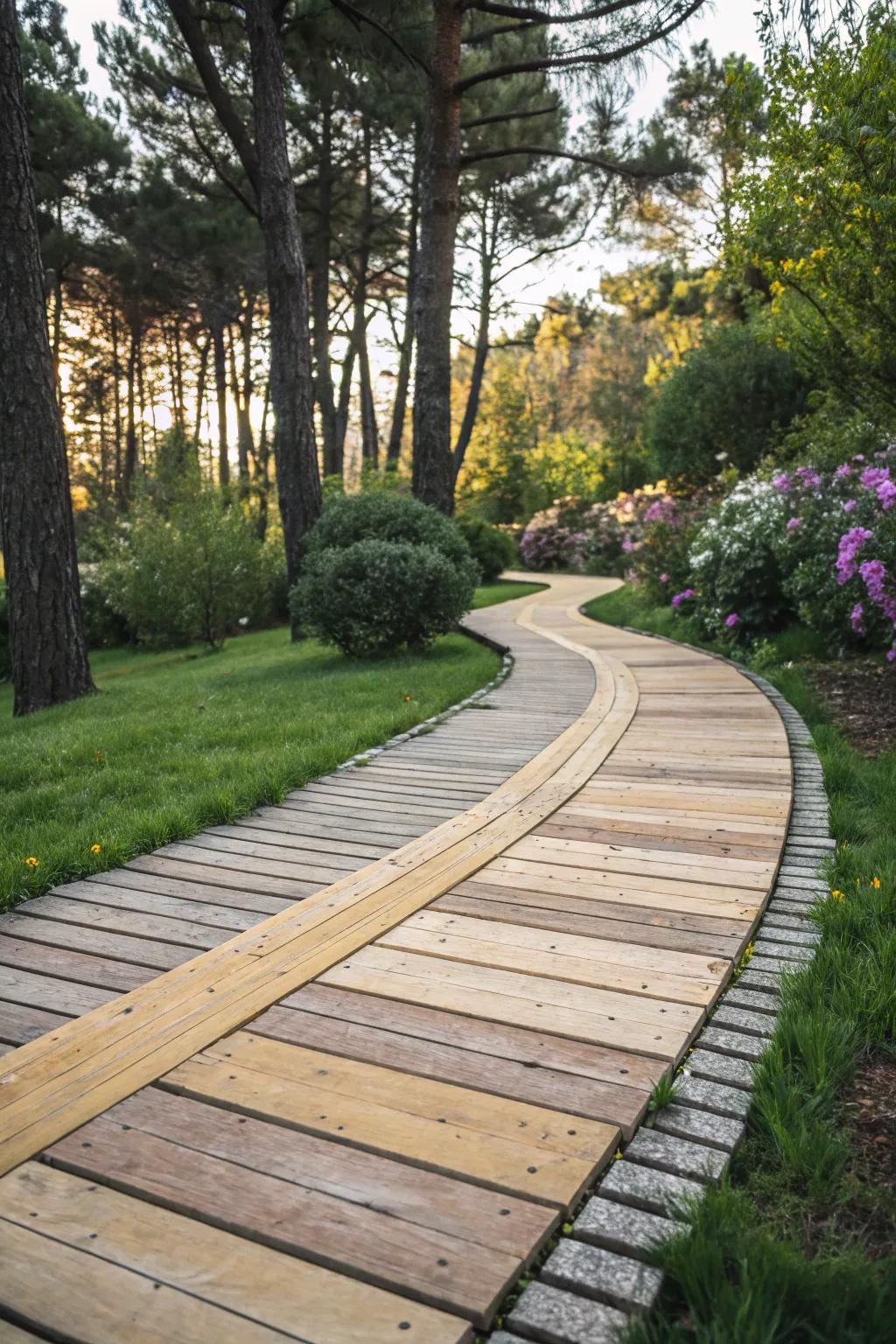
Experiment with different wood shades to complement your landscape. In my garden, a mix of light and dark woods creates a dynamic visual effect that draws the eye.
Check these products out:
- Exterior Wood Stain: Enhance your pathway with rich wood stains for a beautiful and long-lasting finish.
- Wood Deck Tiles: Easily customize your garden path with interlocking wood tiles in varied tones.
- Outdoor Wood Sealer: Protect your wood pathway from the elements with a durable outdoor sealer.
9. Reclaimed Wood Pathway
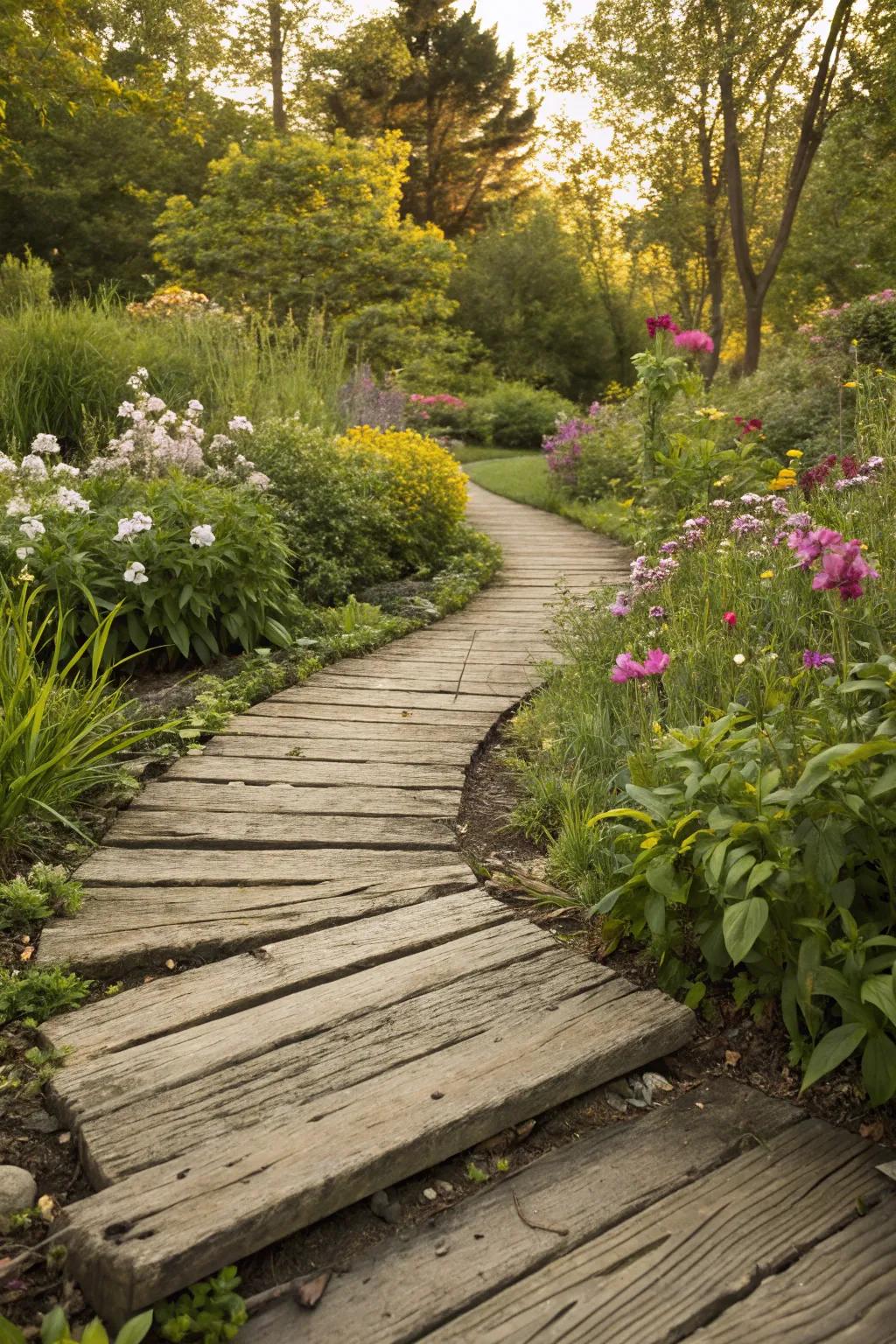
Go eco-friendly by using reclaimed wood for your pathway. I sourced old barn wood for my path, and its weathered look adds a touch of history to my garden.
Some ideas to consider:
- Outdoor Wood Sealant: Preserve your reclaimed wood pathway with ease using a reliable outdoor wood sealant.
- Copper Solar Pathway Lights: Illuminate your reclaimed wood path beautifully with eco-friendly copper solar lights.
- Weathered Wood Stain: Enhance the rustic look of your pathway using this versatile weathered wood stain.
10. Seasonal Decor Accents

Change up your path’s look with seasonal decorations. I love adding pumpkins in the fall and lanterns in the winter, keeping my wooden path fresh and festive.
Explore these options:
- Decorative Outdoor Lanterns: Illuminate your path with charming lanterns to create a cozy and inviting atmosphere.
- Artificial Pumpkins Set: Add vibrant autumn charm with durable pumpkins that enhance your pathway’s seasonal appeal.
- Solar Pathway Lights: Light up your wooden path sustainably with stylish solar pathway lights for winter nights.
11. Pathways with Small Accents

Enhance your pathway with small planters or garden decorations. I added charming terracotta pots along my path, which offer delightful pops of color and interest.
Some handy options:
- Terracotta Planters: Add vibrant charm to your pathway with classic terracotta planters. Enhance your garden’s visual appeal.
- Decorative Garden Lights: Illuminate your wooden pathway with charming decorative lights. Create a welcoming ambiance effortlessly.
- Colorful Outdoor Garden Ornaments: Infuse personality into your garden path with colorful ornaments. Delight in unique visual accents.
12. Mixed Materials
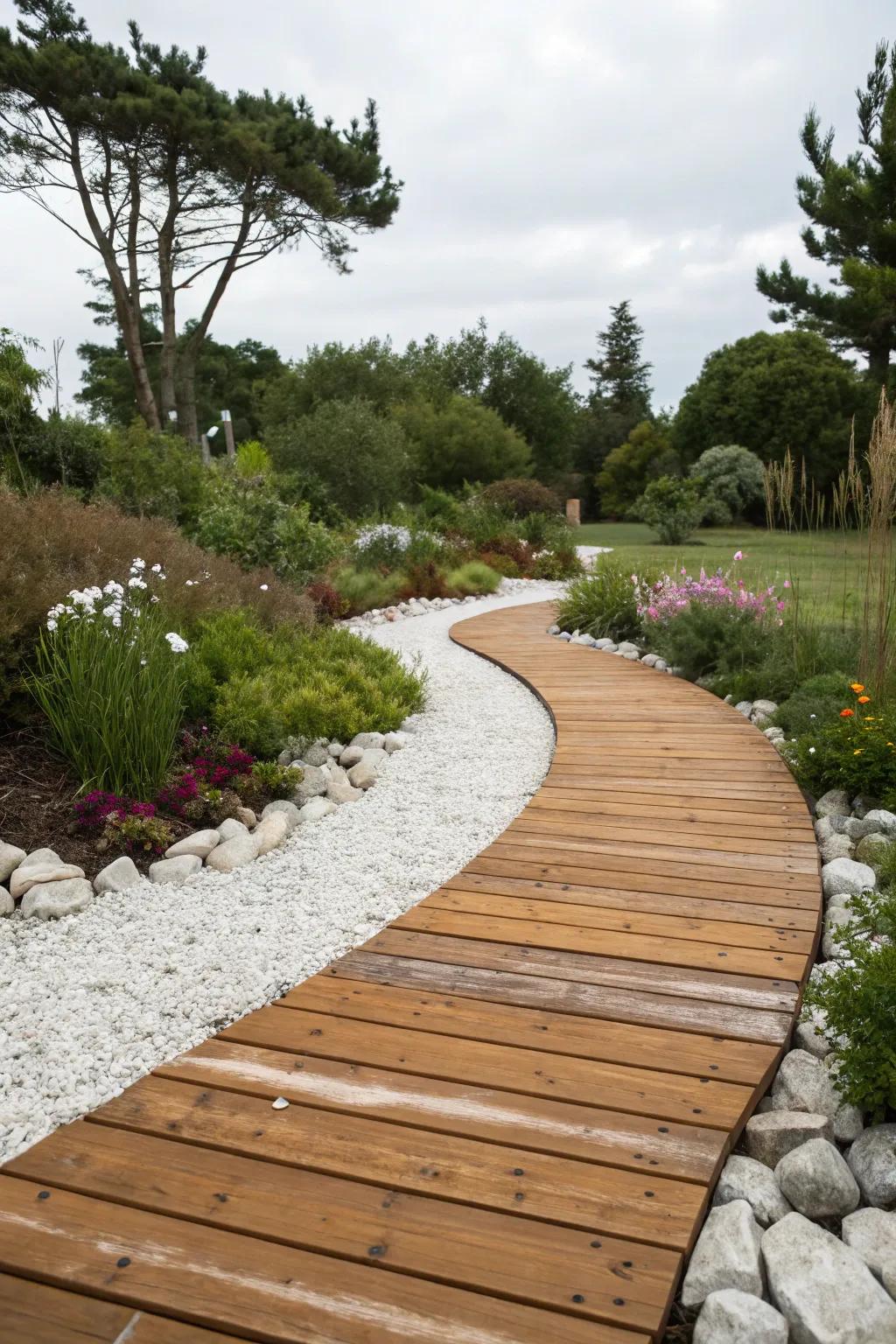
Combine wood with gravel or stones for a textured, layered look. In my yard, I mixed cedar planks with white gravel, which not only adds contrast but also ensures excellent drainage.
A few choices to try:
- Cedar Planks for Outdoor Pathways: Enhance your yard with durable cedar planks, providing natural beauty and weather resistance.
- White Landscaping Gravel: Add contrast and drainage with decorative white gravel for a stunning garden pathway.
- Garden Landscape Fabric: Prevent weed growth and enhance drainage under gravel with quality landscape fabric.
13. Raised Pathways
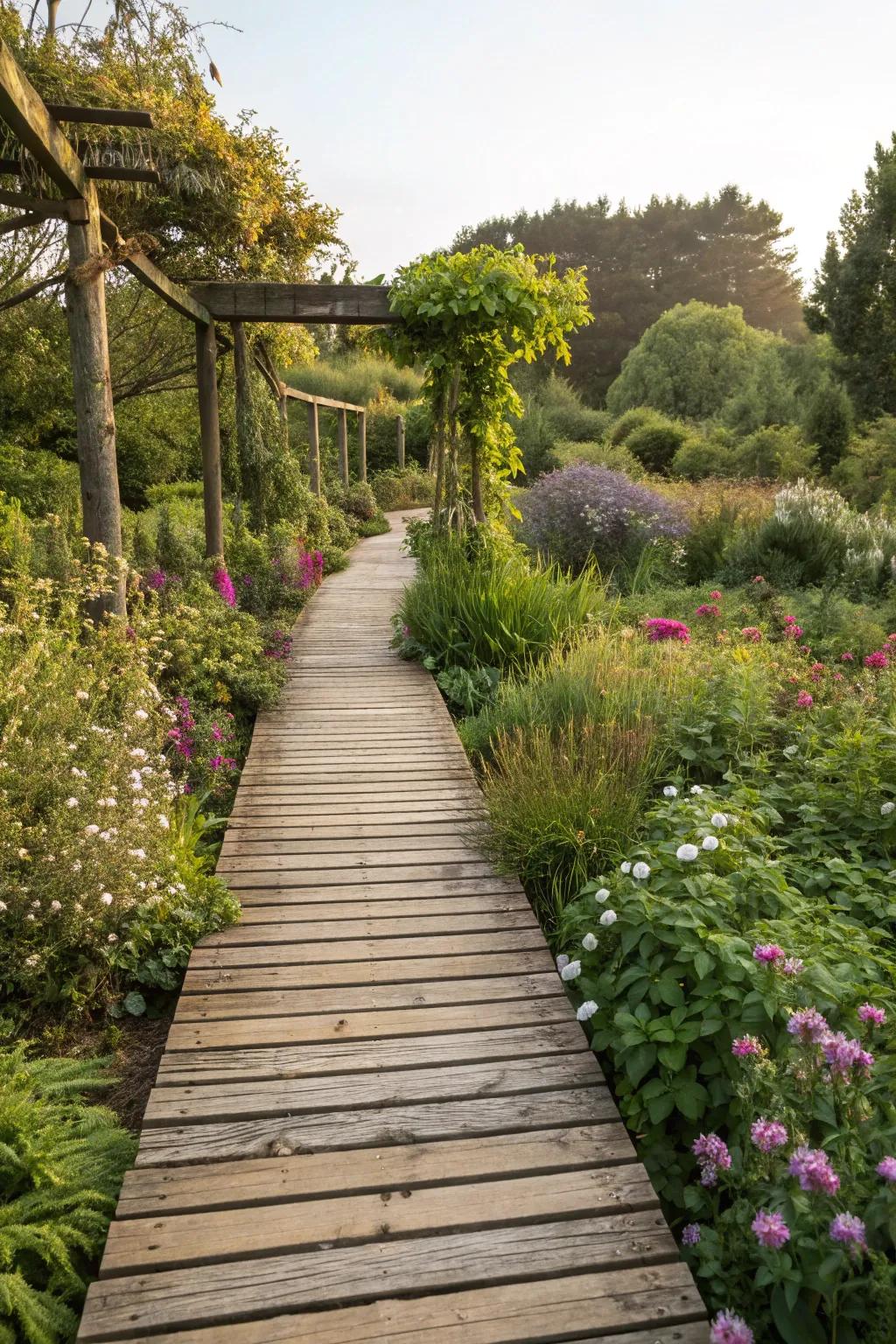
Elevate your pathway to navigate uneven terrain or simply to make a statement. I built a raised wooden path over a small dip in my garden, and it added an unexpected architectural element.
Useful items to consider:
- Pressure-Treated Wood Planks: Enhance your garden with durable wood planks perfect for elevated pathways and weather resilience.
- Outdoor Decking Screws: Secure your raised pathway with rust-resistant decking screws, ensuring stability and long-term durability.
- Garden Landscape Fabric: Use landscape fabric under your pathway to prevent weed growth and maintain a clean appearance.
14. Illuminated Pathways
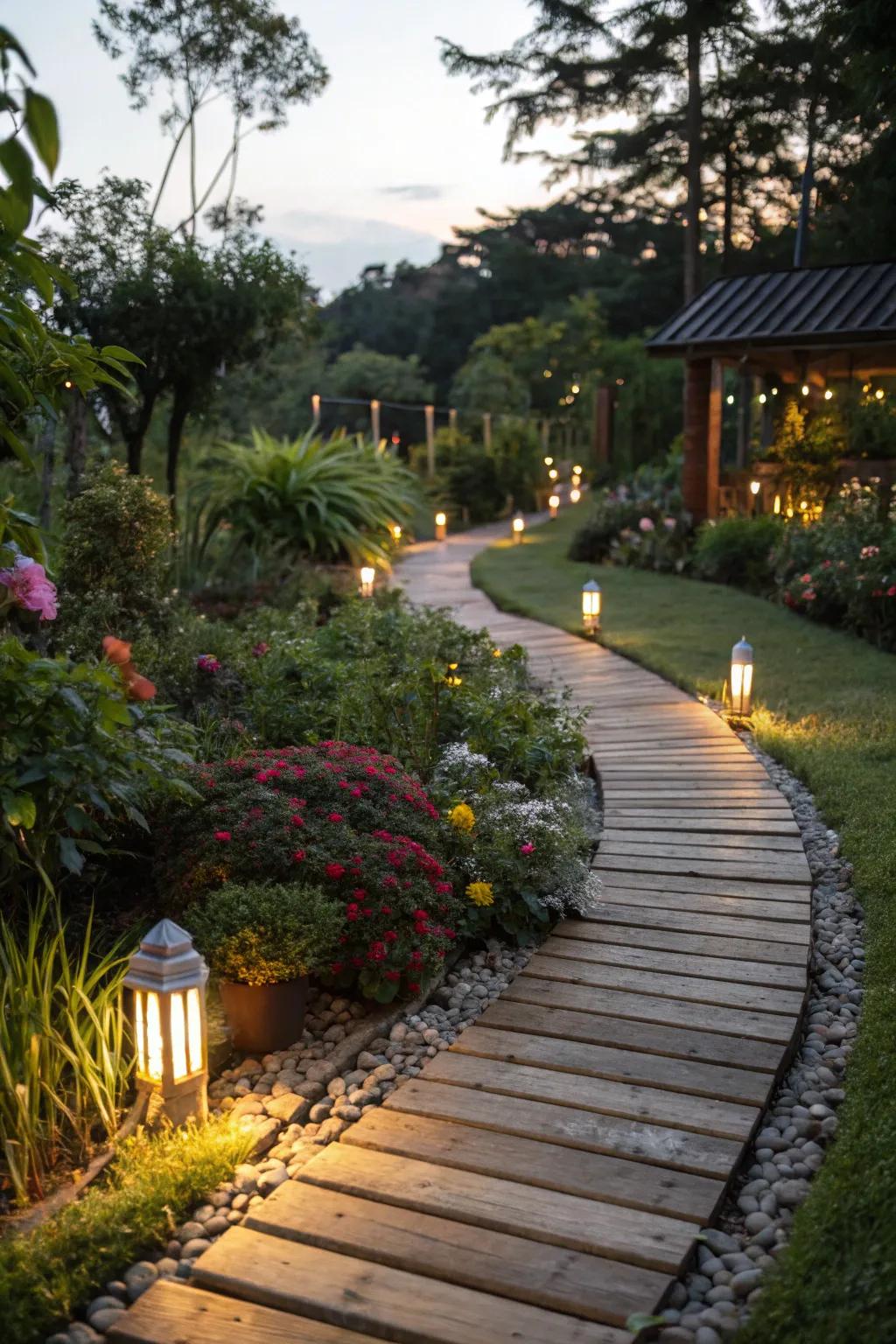
Add soft lighting to your wooden paths for evening ambiance. I installed solar lights along my path, creating a magical glow that guides the way after dark.
Check if these fit your needs:
- Solar Pathway Lights: Enhance your garden path with eco-friendly solar lights for a warm, ambient glow.
- LED Garden Path Lights: Illuminate your walkway effectively with durable, weather-resistant LED lights for evening safety.
- Outdoor Lantern Pathway Lights: Add classic charm to your pathway with stylish lantern lights for a cozy atmosphere.
15. Wooden Boardwalks
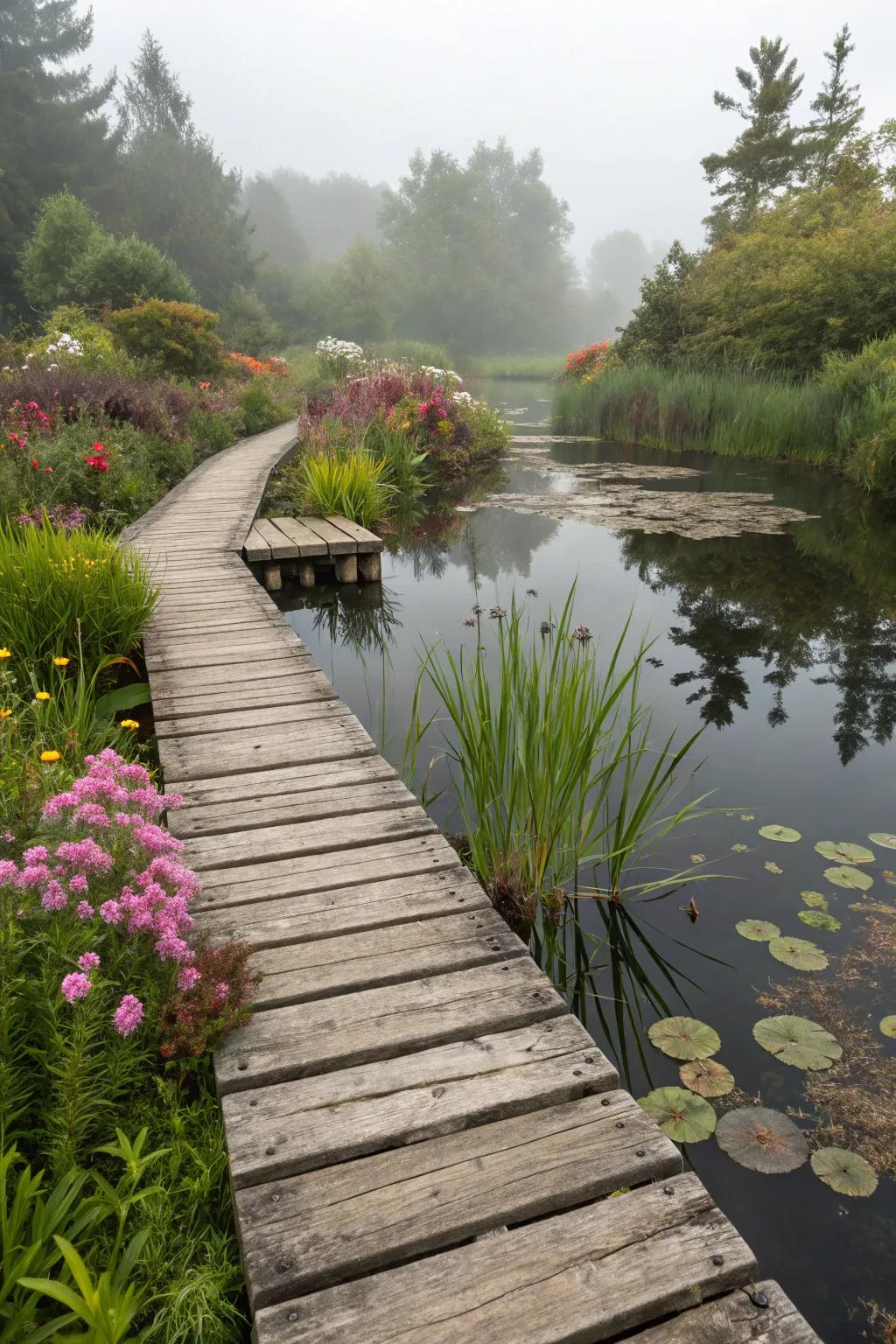
Transform your garden with a wooden boardwalk that feels like a coastal escape. Mine winds over a small pond, adding a touch of whimsy and adventure.
These products might be useful:
- Garden Pathway Lights: Illuminate your wooden boardwalk with solar lights for a magical nighttime ambiance.
- Non-slip Decking Strips: Ensure safety on your boardwalk with easy-to-install non-slip decking strips.
- Protective Wood Sealant: Preserve your wooden boardwalk with a weather-resistant wood sealant for long-lasting beauty.
16. Artistic Pathway Designs
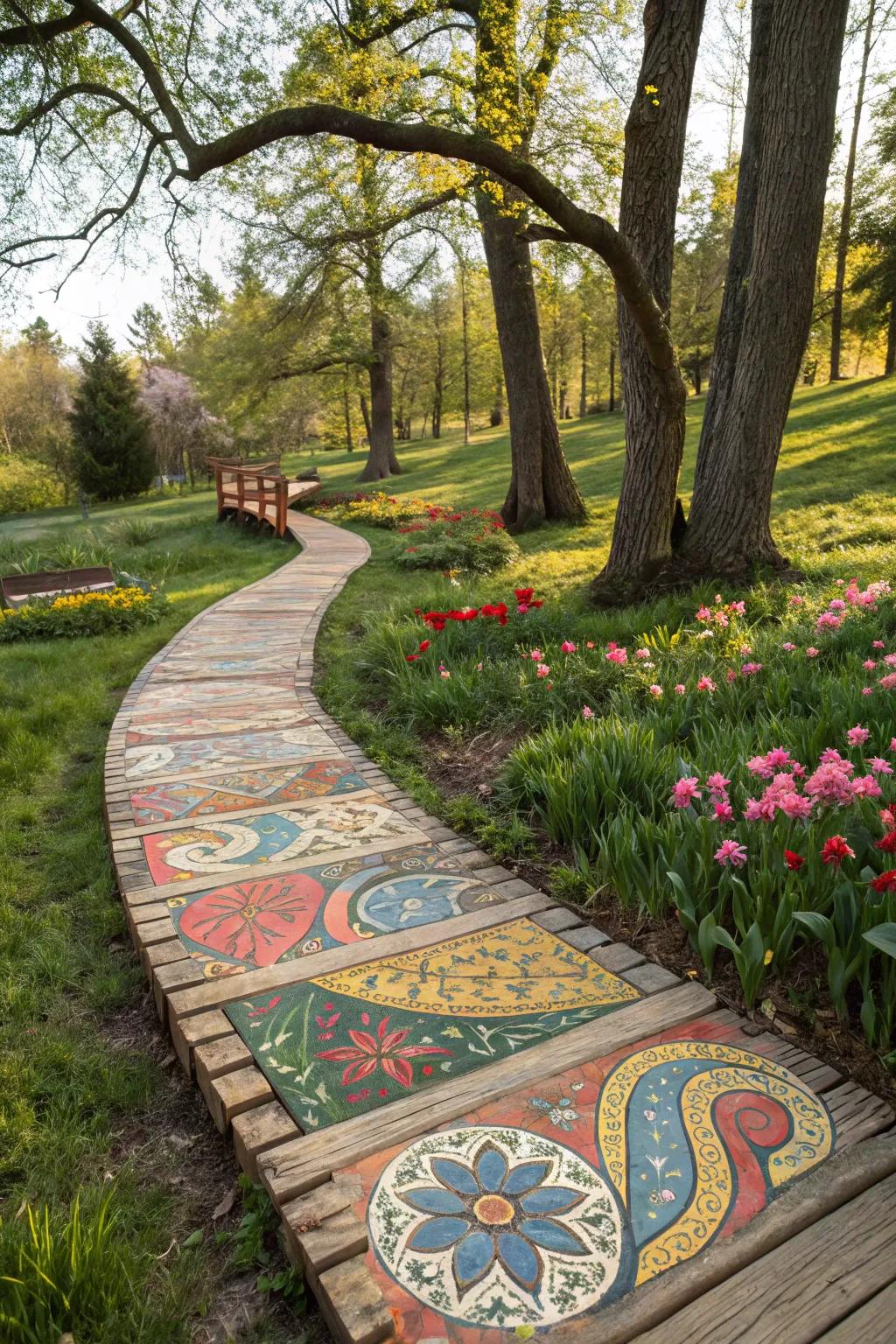
Get creative with artistic designs like mosaic patterns or painted planks. I once painted a pathway with whimsical patterns that became a conversation starter among guests.
Might be a good match:
- Outdoor Weatherproof Acrylic Paint Set: Unleash your creativity on wooden pathways with durable, vibrant outdoor acrylic paints.
- Mosaic Tile Pieces for Outdoor Use: Enhance your pathway with colorful mosaic tiles, perfect for adding artistic flair.
- Decorative Stencils for Woodwork: Create intricate patterns on your pathway with easy-to-use decorative stencils.
17. Minimalist Wooden Paths
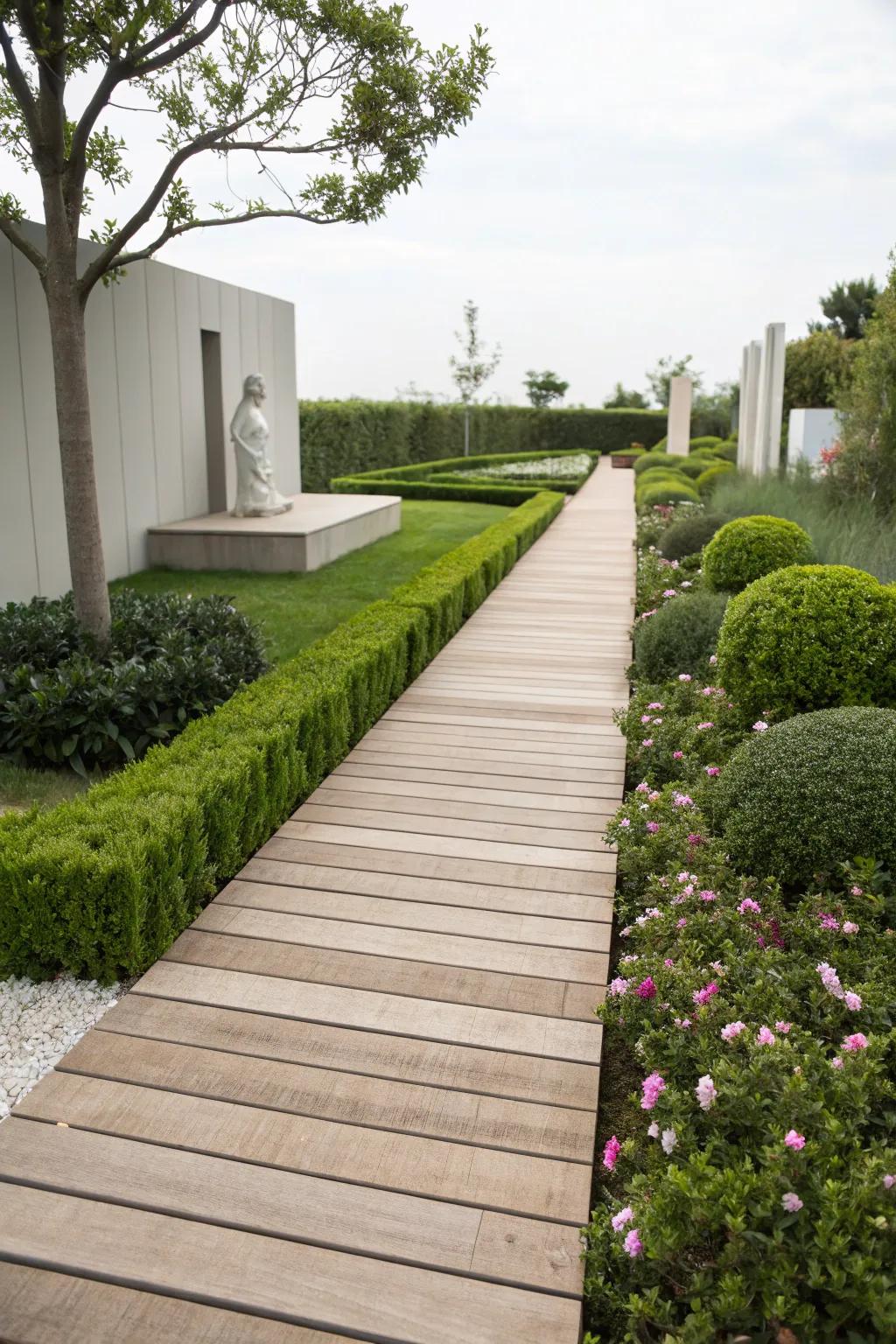
Embrace simplicity with a minimalist wooden path using clean lines and basic shapes. My pathway, with its straightforward design, perfectly complements my modern garden.
You might like:
- Composite Decking Boards: Enhance your garden with durable composite decking for a sleek, minimalist look effortlessly.
- Wood Sealant for Outdoor Paths: Protect and maintain your wooden path’s natural beauty with a reliable wood sealant.
- Minimalist Garden Edging: Define your garden’s borders with sleek edging that complements your wooden path beautifully.
18. Pallet Wood Pathways
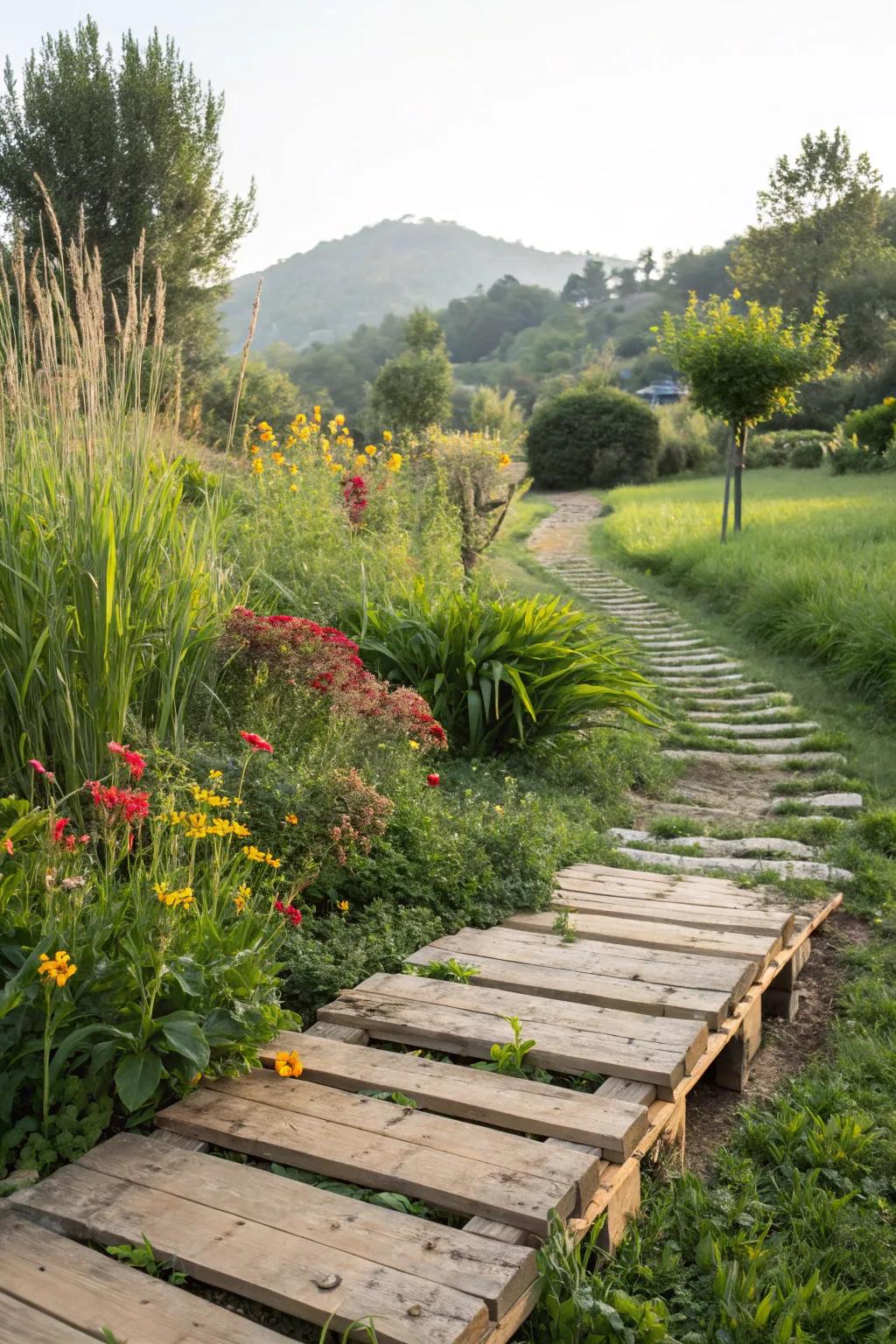
For a budget-friendly option, consider using pallet wood. I crafted a charming path from reclaimed pallets, and it gives my garden a relaxed, rustic vibe.
A few helpful options:
- Outdoor Wood Preservative: Protect your pallet wood pathway from the elements with a high-quality outdoor wood preservative.
- Cordless Drill Driver Kit: Easily assemble your pallet path with a versatile cordless drill driver kit. Perfect for DIY projects.
- Landscape Fabric: Prevent weeds beneath your pathway by laying down durable landscape fabric before installation.
